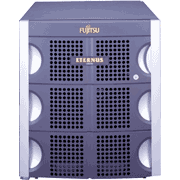Fujitsu’s GR700 series of disk array units was designed specifically for open servers. The GR720 began shipping in December 1999.
The GR700 series worked with storage area networks (SANs) and supported fiber channel interfaces. Furthermore, enterprises could unify management of entire systems that included a SAN by twinning a GR700 series unit with Fujitsu’s integrated operation and management software (System Walker and Storage Manager).
The key feature of the GR700 series was its connectivity with nearly any server type: GR700 units could be connected not only to Fujitsu’s own PRIMEPOWER UNIX servers and PRIMERGY IA servers but also to UNIX and IA servers from Sun, Compaq, HP, IBM, and others. Fujitsu added the GR730 and GR740 in June 2000 and the compact GR710 in February 2001.
The two mid-range models — the GR720 and the GR730 — and the enterprise model — the GR740 — came with an advanced copy function that accelerated online backups of data between disks within a unit. This function benefited system operation because it could shorten the backup window*1 by accelerating the copying or backup of data in use by services. The advanced copy function also greatly reduced recovery times when data were lost by a malfunction or other cause, since backed up data could be restored almost immediately.
- *1. Backup window: To guarantee the integrity of data during a backup, access to the data must be temporarily blocked during backup processing. This time is called the backup window. As systems ran continuously for longer periods of time, there was less time available for blocking access to data. This situation led to the development of the advanced copy function.
The GR740 enterprise model featured an advanced copy function that worked between multiple units as well as within a single unit. This made it possible to create disaster recovery systems where the backup system is situated in a remote location and connected to the main unit by a fiber-channel link.
| Cabinet models | Rack mounted models | |||
|---|---|---|---|---|
| GR72H01 | GR72H02 | GR72G01 | GR72G02 | |
| Initial shipping date | Rack mounted models | |||
| Storage capacity (in a RAID-5 array) | 54 — 1,095 GB | 72 — 2,920GB | 72 — 4,672GB | |
| Number of controllers | 1,2 | 2 | ||
| Host interfaces | Fiber channel (100 MB/s max.) Ultra Wide SCSI (40 MB/s max.) |
|||
| Cache memory | One controller configuration: 256 MB − 1.75 GB Two controller configuration: 512 MB − 3.5 GB |
512 MB − 3.5 GB 256 MB − 1.75 GB per controller |
||
| Number of drives | 4 — 20 | 5 — 50 | 5 — 80 | |
| Supported RAID arrays | 0, 1, 0 +1 (equivalent to 1 + 0), 5 | |||
| Rack mounted models | ||
|---|---|---|
| GR73G01 | GR73G02 | |
| Initial shipping date | June 2000 | |
| Storage capacity (in a RAID-5 array) | 72 — 2,920 GB | 72 — 4,672GB |
| Number of controllers | 2 | |
| Host interfaces | Fiber channel (100 MB/s max.) Ultra Wide SCSI (40 MB/s max.) |
|
| Cache memory | 512 MB — 3.5 GB | |
| Number of drives | 5 — 50 | 5 — 80 |
| Supported RAID arrays | 0, 1, 0 +1 (equivalent to 1 + 0), 5 | |
| Initial shipping date | June 2000 | |
|---|---|---|
| Storage capacity (in a RAID-5 array) | 144 GB — 13.7 TB | |
| Number of controllers | 2 — 4 | |
| Host interfaces | Fiber channel (100 MB/s max.) Ultra Wide SCSI (40 MB/s max.) |
|
| Cache memory | 1 GB — 32 GB | |
| Number of drives | 10 — 240 | |
| Supported RAID arrays | 0, 1, 0 +1 (equivalent to 1 + 0), 5 | |


